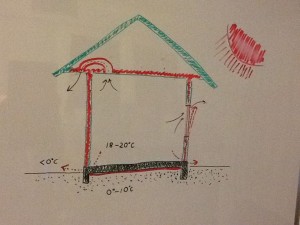Podcast: Play in new window | Download | Embed

UPDATE: Check out this article for a list of slab edge insulation solutions, and episode 125 for my interview with Henry Edney of MAXRaft.
The first thing to consider when looking into different types of concrete floors is why it’s so important to insulate the floor slab. To do this, we need to consider where heat can be lost from the concrete. It’s reasonable to believe that most of the heat will be lost where the greatest surface area is, down into the ground. Right?
How much heat do you think is lost through the sides of concrete floor slab?
Would you believe that it’s as much as 80% of the total floor heat loss? That’s right. It’s the old Pareto, 80-20 rule with concrete floors. 80% of the heat is lost through 20% of the total surface.
Why is this the case? There are two main reasons that I know of…
1. The edge of the concrete floor slab is usually uninsulated
The sides of the concrete slab, also referred to as the perimeter wall, is often forgotten or not considered at all with respect to the thermal envelope. Remember that the thermal envelope is the boundary between the inside conditioned space, and the outside. Any gab in this thermal envelope is an avenue for heat loss, known as a thermal bridge.
Unfortunately it’s relatively common in New Zealand, to leave the perimeter edge of the slab exposed. Have look next time you see any house with a concrete floor. If you can see a strip of plain concrete between the base of the cladding, and the ground, then you’re looking at one end of a very effective thermal bridge that will leak heat.
2. Air gets colder than the ground
Picture this. A cold, frosty, winter’s morning. It’s -3 degrees outside. What exactly is -3 degrees? The ambient air is. The ground, just

below the surface will be a bit warmer than this. And the ground underneath your house will be warmer still (because there’s a relatively warmer house sitting on top of it).
So while the ground is still cold, and therefore worthy of insulating from the floor, it’s the cold air around the perimeter of the house the we should be most concerned with.
The Solutions
There are number of ways to reduce the heat loss through the side of your concrete slab, but they all start with you demanding it from your builder or designer. And if you are the designer, then you may need to sell the idea to your client, and ensure that your chosen method gets properly built.
Bulletin number 552 ‘Edge insulation of concrete floor slabs’ from BRANZ outlines the accepted solutions for installing edge insulation or a thermal break between the slab and the perimeter wall.
However, I think by far the best option is one that offers complete insulation from the ground. Maxraft offer just this type of complete solution and I caught up with Quantity Surveyor, Craig Lonsdale from Queenstown to find out more about the Maxraft system.
A concrete floor is an excellent solution for a high performing home. But to make the most of the thermal mass benefits of concrete, the slab and foundation should be insulated from both the ground and the air.
Check out the podcast episode and please feel free to leave you comments or questions.
Leave a Reply